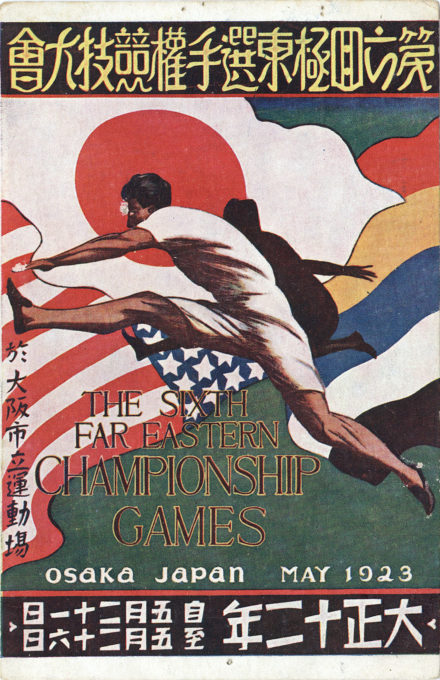
The 6th Far Eastern Championship Games advertising postcard, 1923. Hosted in Osaka from May 21-26, the biennial Far Eastern Games were first organized in 1913 as the “Far Eastern Olympics” 1913 by Philippine Amateur Athletic Association president Elwood Brown and Philippine Governor-General William Cameron Forbes. Established primarily as an amateur athletic competition between the U.S. colony of the Philippines, China, and Japan, participation in the Far Eastern Games was expanded to include the British East Indies (Malaysia), the Kingdom of Thailand and the British crown colony of Hong Kong.
See also:
Meiji Shrine Games, Tokyo, 1926.
Meiji Jingu Outdoor Swimming Pool, Tokyo, c. 1935.
“The Sixth Far Eastern Championship Games were held during the week of May 21st [1923], at the new City Stadium of Osaka, Japan.
“These Games, bringing together the three great nations of the Far East [China, the Philippines, and Japan], have an international influence second in importance only to the Olympic Games themselves.
“For six days over five hundred athletes competed in track and field sports, swimming, tennis, baseball, soccer, basketball and volleyball and, quoting from the Japan Advertiser, ‘not one case of glaring unsportsmanship has been shown; in fact, the entries have extended themselves to give their opponents every possible chance.’ No one who knows the intensity of international feeling in the Far East will miss the significance of such a statement.
“It was evident on the first day that Japan had made the most rapid advancement of the three countries since the Fifth Games at Shanghai two years ago. As always, the track and field sports held the center of the stage, and it was the first time since the Far Eastern Athletic Association was organized in 1913 that this championship was not won by Uncle Sam’s proteges.
“The Japanese are very proud of the temporary possession of the beautiful new cup presented by Governor-General Wood, particularly as it was a hard won victory. That the Oriental athletes believe in progress is evidenced by the fact that in the seventeen events on the track and field program eleven records were broken and one equalled, and this in spite of the two days of hard rain.
“All three countries shared in the record smashing. The Philippines and China had swimming teams that far surpassed their representatives of two years ago, but the Japanese won nearly all the places in every race and broke every Far Eastern record. The Japanese tennis players – Toba, Harada, Abe, and Kawazuma – took every match in both singles and doubles, though the Japan Davis Cup team was in America.
“… The Osaka municipality erected a splendid concrete stadium enclosing a cinder running track 400 meters in circumference. At one end of this field is a new concrete swimming pool 50 meters long, with its own grand stands. Football, baseball, and tennis were played on separate fields close by. The stadium, with its track athletic field, and swimming pool, now forms a permanent city recreational plant.
“The Games drew an average attendance of over forty thousand a day for six days, and thousands were unable to get in. On two of the most important days rain fell steadily but it had very little effect on the attendance, for over twenty thousand people were in the stadium by ten o’clock in the morning waiting for a track and field program scheduled for one o’clock! A most attractive feature of the daily program was a half-hour demonstration of mass games and play by groups of Osaka school children, boys and girls, and by young men’s organizations. These groups varied in numbers from five hundred to five thousand.”
– “The Sixth Far Eastern Championship Games”, by Franklin H. Brown, Physical Training, October 1923

